2012-2013
2011-2012
Low Cost Adjustable Prosthetic Leg
Team Members: Jenee’ C. Jordan, Clint L. Beaird, Lauren E. McCalmont, and Kyle Neufeld
Project Sponsor:
Faculty Advisor: Dr. Patrick O’Neal
Summary: The overall goal of this device is to create a low cost, adjustable, and durable transtibial prosthetic limb for children in developing countries. Pediatric prosthetics must be replaced every six to twelve months as a result of the quick rate at which children grow. Current solutions providing low cost prosthetic limbs to persons with transtibial amputations do not account for the growth of the individuals. Current solutions utilize one pylon systems or complete prosthetic leg systems, which have to be fully and completely replaced when the child outgrows the system. The adjustable prosthetic limb system designed provides a long-term solution while still fitting the needs to be durable, low-cost, high strength, and easily available. The device is an adjustable prosthetic leg, consisting of an adjustable pylon system and a carbon fiber resin composite (CFRC) foot. The pylon system adjusts for growth from 9.5in to 16.5in. It uses a clamp system to hold the 2 industry-standard pylons together. The growth range supports children from ages 7 to 17 years old and supports a maximum weight of 300lb. This device will enable a child to use a prosthetic leg for years at a time, eliminating the need to travel to clinics or overseas for fittings for new prosthetic legs. The caregiver can loosen the bolt on the clamp and adjust the prosthetic to the length of growth of the matching limb. This design allows the child to use one pylon system for a 10 year period. The International Council for the Red Cross (ICRC) currently provides low cost, short-term solutions, but the adjustable prosthetic limb system provides a long-term solution. This device could potentially replace existing products the ICRC uses.
Easy Plug
Rikesha George (w/ )
Project Sponsor:
Summary: Individuals with arthritis or Parkinson’s disease experience limited upper-body strength, limited dexterity, poor coordination and tremors of the hand. These physical constraints can make it difficult and unsafe to plug in electrical devices. Several devices and patents exist for mechanisms that will reduce the force or coordination needed to make a proper electrical connection; however, these designs do not reduce force and coordination simultaneously. The Easy Plug (EP) was designed to minimize the strength and coordination needed to plug appliances into electrical outlets. This project improves upon a previous generation from senior design of the previous school year. The design consists of two adapters: a wall adapter and an appliance adapter. The wall adapter houses a male bridge and wiping contacts connected by 14-gauge solid copper wire. The wiping contacts receive the male blades housed in the appliance adapter. The male blades and their receptacles (openings on the wall adapter face with wiping contacts behind them) were placed in a triangular fashion that mimics the prong placement of a 3-prong plug. The triangular placement and distances between the pins are standard. The appliance adapter also houses the female bridge that connects to the male blades via 14-gauge wire. Each part is 120V/15A rated or higher. The parts’ ratings allow the parts to be used in standard American home outlets. The device design incorporates a guide system around the receptacles that receive the male blades of the appliance adapter. The guide system reduces the coordination needed to connect the two adapters. Neodymium magnets are used to help reduce the force needed to connect the adapters and make a proper electrical connection. The magnets are placed behind the two adapters’ interfaces in order to bring the adapters together. The fully-assembled device only requires the user to install the wall adapter and the appliance adapter for use.
The i-Chair: A Thought and Eye Movement Based Wheelchair Drive Control System
Team Members: Chelsea Dressel, Jessie Theobalds, Osayd Sawalha, Ryan Romance, Titly Dhar & Zakariae Yerrou
Project Sponsor:
Faculty Advisor: Dr. Alan Chiu
More than 230,000 individuals in the United States live with some form of paralysis. More than half of these individuals use electric wheelchairs for mobility. As a result, several electric wheelchair drive control systems have been developed to cater to the preference or degree of immobility of wheelchair users. A drive control system that allows a person to navigate an electric wheelchair using thoughts and eye movements is designed to minimize the physical effort needed for operation. The system uses a headset designed by Emotiv to collect brain and eye signals. These signals are processed through programming and are converted to voltages that direct the wheelchair in four different directions: 1) left, 2) right, 3) forward, and 4) reverse. The i-chair drive control is composed of three major parts: 1) the EPOC neuroheadset from Emotiv, 2) the LabVIEW programs, and 3) the NI-USB-6210 data acquisition device (DAQ) from National Instruments. The neuroheadset is used to detect raw electroencephalograph (EEG) and electrooculograph (EOG) signals from the user. These signals are processed using LabVIEW graphical programming. A classification matrix discerns four distinct signal patterns and assigns them to four distinct Boolean commands. These commands send voltages of to the DAQ’s two analog outputs to control the movement of the wheelchair. The i-chair drive control system could serve as a replacement for other drive control technologies, improving the quality of living of persons with paraplegia.
GloCam
Team Members: Megan Carroll, Austin Hoggatt, Aaron Rogers, and Erik Woodard
Project Sponsor:
Faculty Advisor: Dr. Patrick O’Neal
One of the predominant clinical problems of today is the inability to diagnose superficial tissue cancers (i.e. skin, nose, throat, or breast) in a cheap, quick, and non-invasive manner. Therefore, it is prudent to find methods to reduce costs, time, and invasive techniques for cancer detection. The design project intends to address this problem by using inexpensive fluorescent technology coupled with the abnormal pH characteristics of tumor cells to provide a low cost image based cancer detection system. The imaging technique revolves around studies demonstrating that tumor pH is consistently lower than that of normal tissue; therefore, one can detect the difference by using a fluorescent chemical that would produce an intensity gradient in the presence of an abnormal pH. When imaged by the device, the change in pH would appear as a discontinuity in the color or brightness of the fluorescent emission, signifying the presence of a tumor. Major challenges to implementation include the ability to detect relatively small pH changes in the range of 6 to 8 in living tissue, as well as devising methods for deep skin penetration using fluorescent compounds. The immediate impact of this system lies in its ability to potentially detect early stages of superficial cancers. A noninvasive technique to quickly and affordably detect cancerous tissue will encourage increased cancer screening by replacing invasive techniques. The novelty of this system lies not only in its specific application, but also in the enhanced understanding of pharmacokinetics and human skin permeability. This knowledge could be utilized in a variety of applications in addition to exploiting the specific characteristics of cancerous tissue.
2010-2011
Water Diagnostic Device
Team Members: Sajin Killa, Anil Patel, Omar Alamoudi, Anagh Pradhan
Project Sponsor: Louisiana Tech University
Faculty Advisor: Dr. Chester Wilson, Mr. John Sweeney
Wastewater analysis is an important aspect of environmental management as well as supporting the control of industrial effluents. The main objective of the project is to build and test a capacitive sensor that can be used in water diagnostic device to measure the concentration of contaminant present in waste water. The capacitive sensor is based upon the basic capacitance formula which states that capacitance is directly proportional to the area of parallel plates and inversely proportional to the distance between the plates. Capacitance at different concentrations of contamination is measured using the AD7746 board and its software. A calibration model allows the conversion of capacitance to concentration. The results obtained are then statistically analyzed to determine the sensitivity of the instrument to measure capacitance at different concentrations of contaminants.
Artificial Hand Project
Team Members: Benjamin Key, Ben Kemp, Dylan Snyder, Beau Downey
Project Sponsor: Louisiana Tech University—CREST - Michael Shipp
Faculty Advisor: Dr. Alan Chiu
The absence of a hand is a major obstacle to overcome in order to accomplish activities for daily living (ADL). The 4th generation artificial hand prototype created by Chiu et al. has problems concerning durability, gripping force, slippage, size, and weight. The team has worked with Dr. Chiu et al. to design the 5th generation artificial hand which focuses on increasing gripping strength by improving motors, increasing durability of structural materials, examining new cover designs to reduce the slippage of objects during usage, and having the final product be manufactured for under $350.
Mobile Integrated DNA Analyzing System
Team Members: Farial Afroze, Natalie Lemelle, Nishi Mehta, Louis Reis
Project Sponsor: Louisiana Tech University
Faculty Advisor: Dr. Niel Crews
The Mobile Integrated DNA Analyzing System (MIDAS) was designed for the rapid analysis of the presence or absence of a select DNA sequences. The device was designed for hospitals to detect the presence of methicillin-resistant Staphylococcus aureus in patients and medical staff. The MIDAS uses spatial-domain analysis to determine DNA presence, as opposed to the slower time-domain analysis. In its second year, MIDAS is now equipped with an updated optical system and a more condensed system controller.
Electric Slide
Team Members: Rae Henson, Katie Simmsons, Brennon Cucullu, Chris Garcia
Project Sponsor: Louisiana Tech University—CREST - Michael Shipp
The team designed a magnetic electrical outlet adapter that will aid persons with disabilities to use an electrical outlet without the assistance of another person. The target consumer for this product would be a person lacking in fine motor skills or upper body strength required to plug in or unplug an electrical device from a wall outlet.
Adaptive USB Data Transfer Technology
Team Members: Breyanna Gordon, Brad Bolton, Bernard Cazenave
Project Sponsor: Mike Shipp, Louisiana Tech University CREST
Citizens with disabilities represent a growing sector in the modern workplace. By redefining the interface for USB connection, individuals with limited upper limb mobility will regain independence and control by having an adaptive method to transfer data. Our prototype involves a purely mechanical apparatus that aligns a USB with the connection ports on a hub by dropping the USB into the channel and slightly pushing a metal plate forward. Designs are developed using Solid Works for reproduction in ABS plastic and 0.021 steel. Product specifications are verified through ease-of-use tests and slider force tests to define continuous run time success and dependability of prototype structure for overall satisfaction.
2009-2010
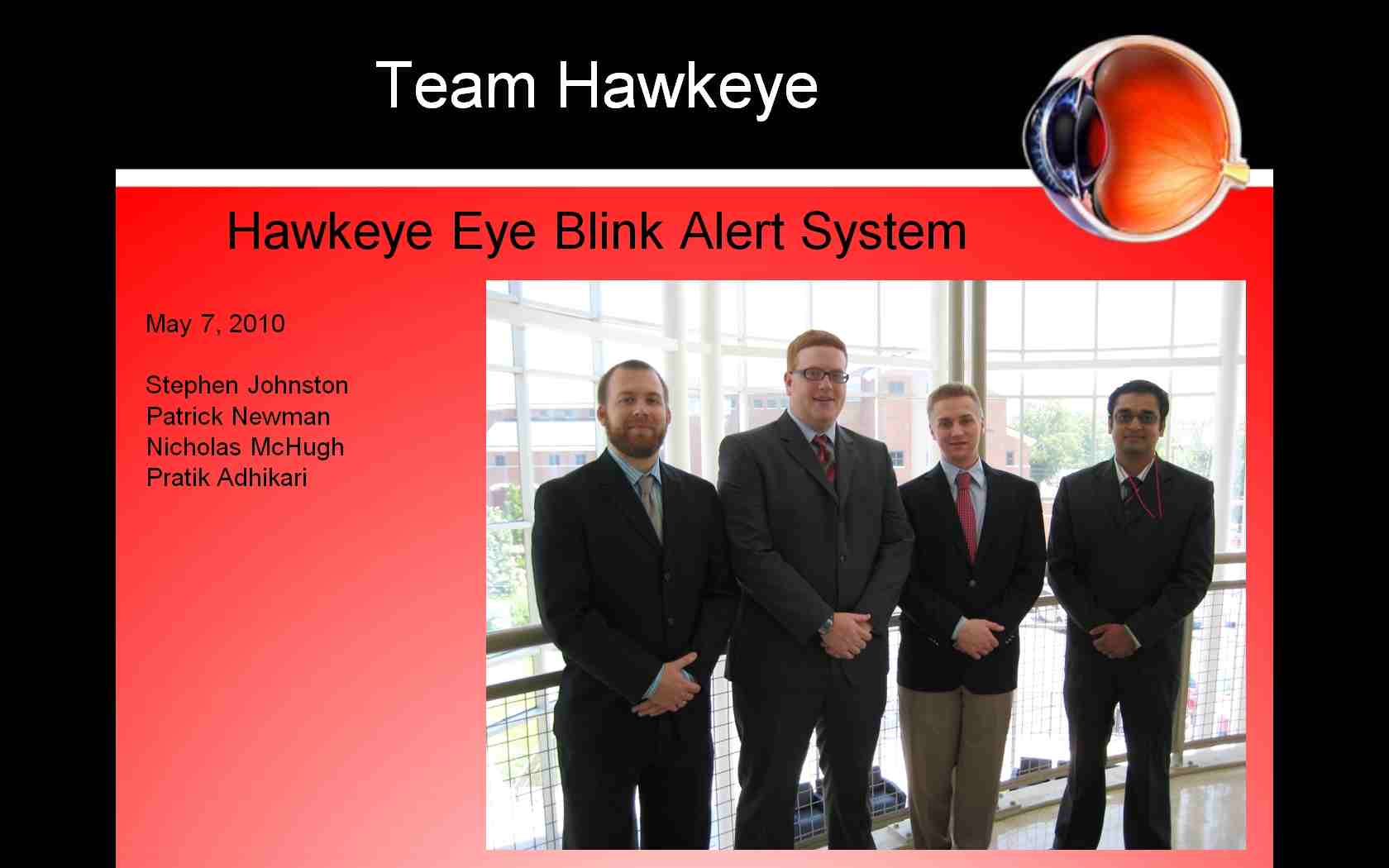
Eye Blink Detection Alarm for Patients with Degenerative Neuromuscular Diseases
Team Members: Pratik Adhikari, Stephen Johnston, Nicholas McHugh, Patrick Newman
Project Sponsor: Louisiana Tech University—CREST - Mike Shipp
The group constructed a novel alarm system based on eye-blink detection for patients with degenerative neuromuscular diseases. Adaptations to the design include: reduced system requirements with higher stability, wireless communication to alarm, and a user-friendly setup and interface. The team achieved a 96% blink detection rate and reduced false positives to <1%. Future goals are to field test the working device on a CREST consumer and make final modifications based upon feedback.
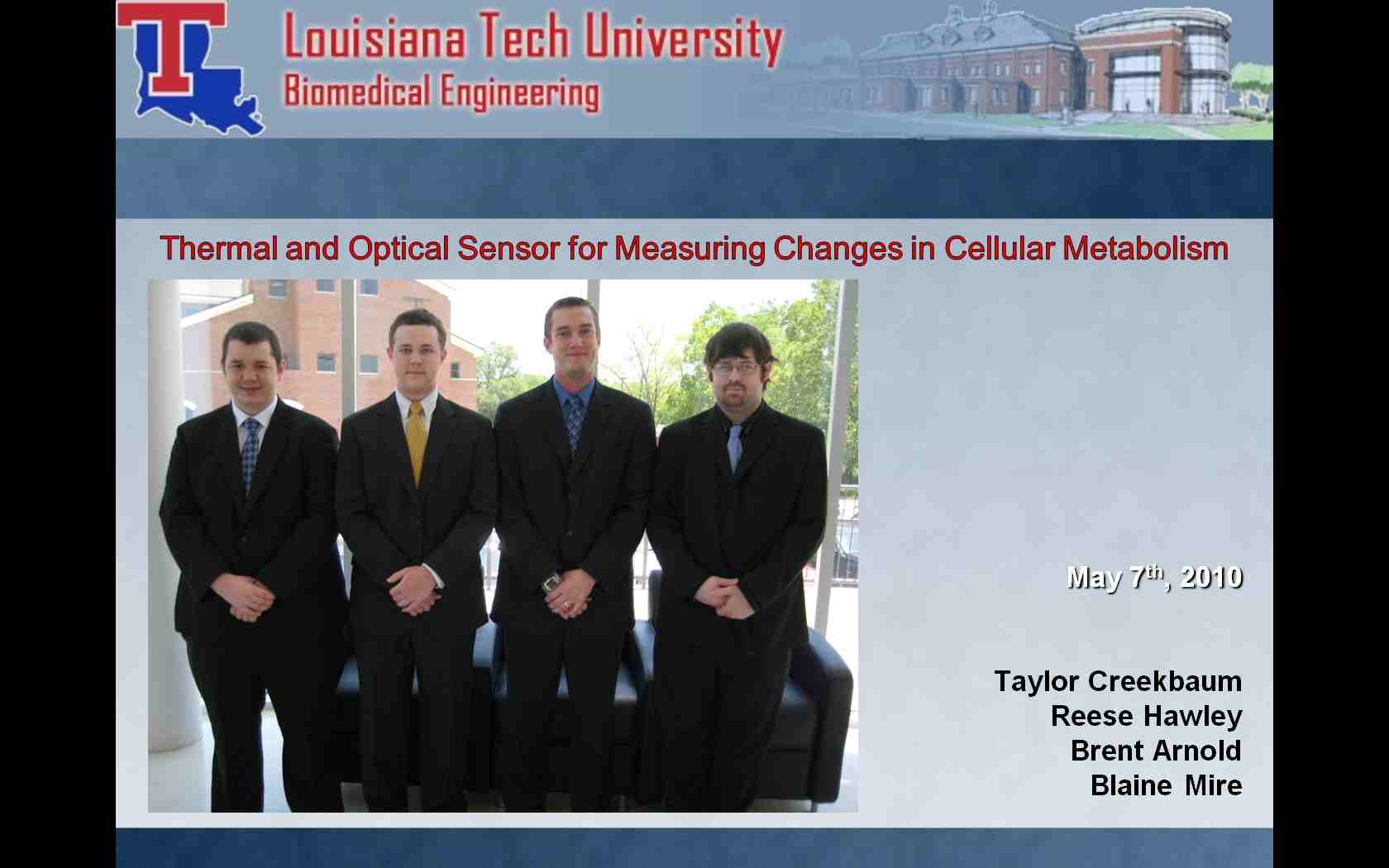
Thermal and Optical Biosensor for Measuring Changes in Cellular Metabolism
Team Members: Brent Arnold, Taylor Creekbaum, Reese Hawley and Blaine Mire
Project Sponsor: Louisiana Tech University—CBERS
Faculty Advisor: Dr. Eric Guilbeau and Dr. Mark DeCoster
Currently, there are few methods for continuously monitoring in vitro cell metabolism. A device that utilizes a thin film based thermopile would not only be an efficient means of continuous measurement, but it would offer a building block for nearly autonomous testing. The goal for this project is to demonstrate the feasibility of using a thermopile for measuring cellular metabolism, and the results that will be collected include the voltage output of a baseline temperature reading without cells, an increasing voltage linked to a growing colony, and a voltage drop consistent with the death of a colony via a chemotherapeutic agent.
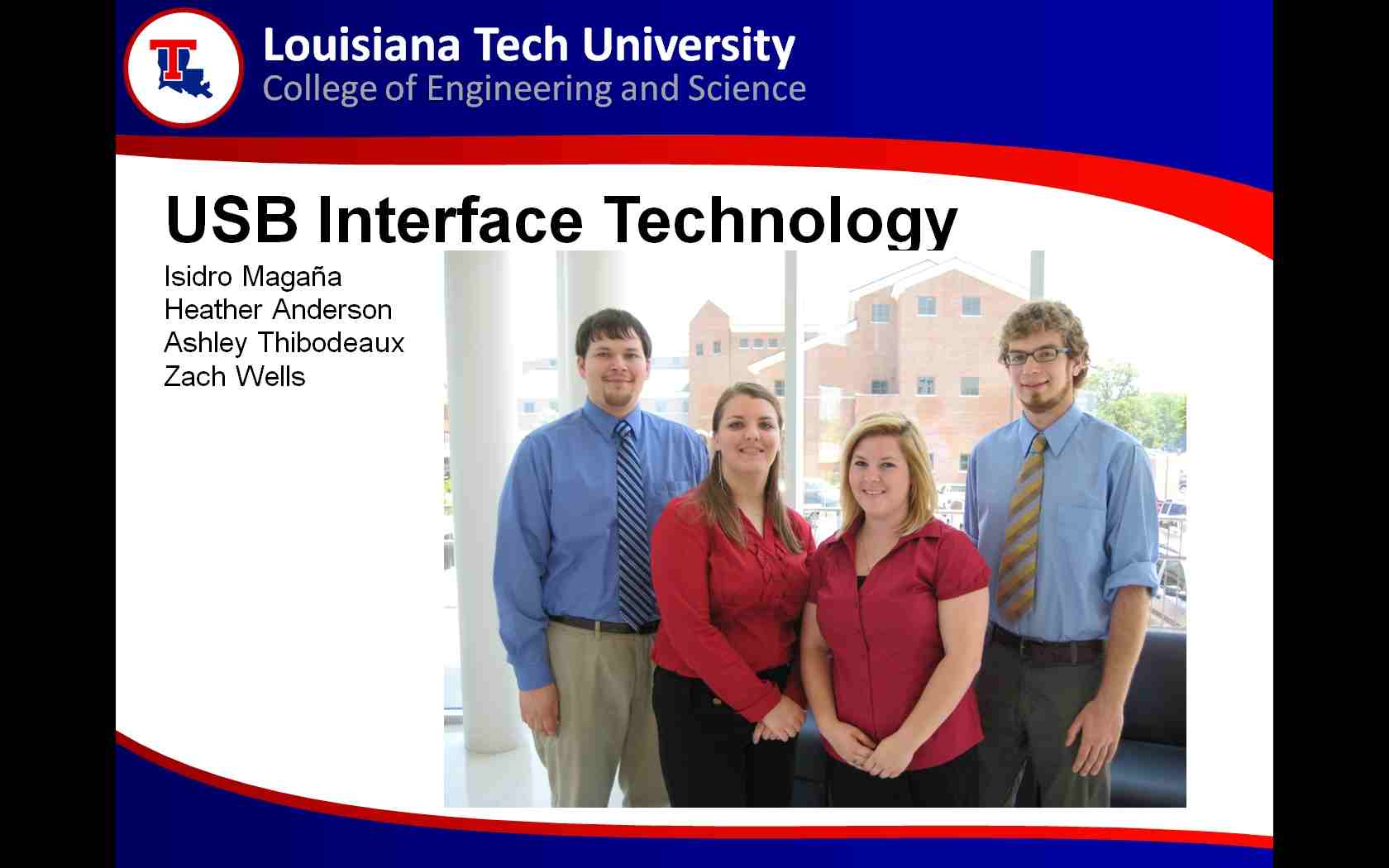
USB Interface Technology: Team USB
Team Members: Isidro Magana, Heather Anderson, Ashley Thibodeaux, Zach Wells
Summary: Individuals with spinal cord injuries have limited motor function and thus have difficulties plugging USB devices into computers. We propose to replace the physical element of USB connections with magnetic force over copper leads housed in an ABS casing. This will allow for consumers to easily connect and disconnect USB devices without fine motor skills. The device has been tested for data transfer speeds to ensure it meets USB 2.0 specifications. The device has also been tested with consumers of varying mobility levels to determine overall satisfaction with the proposed solution.
2008-2009

Feasibility Study of Alternative Power Sources for Portable Medical Devices: Team Green Medical
Summary: Medical devices comprise an $86 billion dollar market in the United States, and many portable devices are powered by disposable batteries. Patients need portable medical devices that are less dependent on batteries to provide greater freedom. While under constant use, the battery life of a portable device ranges from ten hours to one week, and replacing batteries can be time consuming and expensive. Patients living in rural areas or developing countries may have limited access to new batteries. Self-generating power sources would reduce the cost of operation and allow portable medical devices to become more accessible to lower income individuals, including those in developing nations. Medical devices such as pulse oximeters, pulse detectors, hearing aids, and portable insulin pumps are some of the products that can potentially utilize self-generating power sources. There are many types of energy harvesting devices that are currently available: photovoltaic, thermoelectric, hydroelectric, wind turbines, and piezoelectric sources. Energy harvesting devices work by transferring mechanical, thermal, or solar energy into electric power. The three forms of energy harvesting examined by our company are thermoelectric, peizoelectric, and photovoltaic. Using various combinations of these sources, patients could produce power for a medical device using sunlight, body heat, or body movements. The anticipated end result of this project is the development of an alternatively powered pulse oximeter.
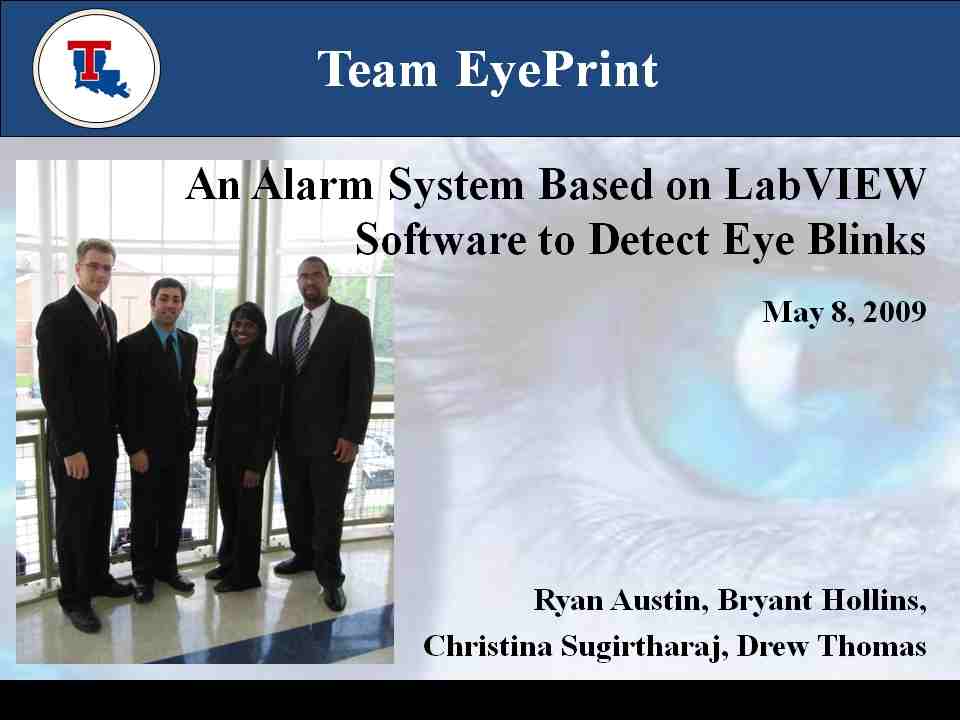
An Alarm System Based on LabVIEW Software to Detect Eye Blinks: Team EyePrint (Sponsor: CREST)
Summary: Over one million Americans are diagnosed with a degenerative disease such as Parkinson's disease, Multiple Sclerosis, and Amyotrophic Lateral Sclerosis. As these diseases progress, communication between a caregiver and a diagnosed individual becomes difficult. With the advancement of eye tracking technology, individuals with degenerative diseases can communicate better with caregivers. Integrating eye tracking technology into a computer, an assistive technology devices is created that allows for easier communication. These devices require a computer screen to work; however, at night the screen's glare makes sleeping difficult. The individual has to decide whether to sleep with the glare and risk sleep deprivation or turn off the system and risk not being able to get assistance when needed during the night. Our device is an active emergency alert system designed to operate in a sleeping environment. Using an infrared light source, the individual can sleep peacefully while still feeling safe. The parts needed are commercially available and affordable. The system is user-customizable, reducing the resources needed to monitor an individual at night. All these features make our product a great choice to supplement existing assistive technologies for individuals with degenerative diseases.
2007-2008
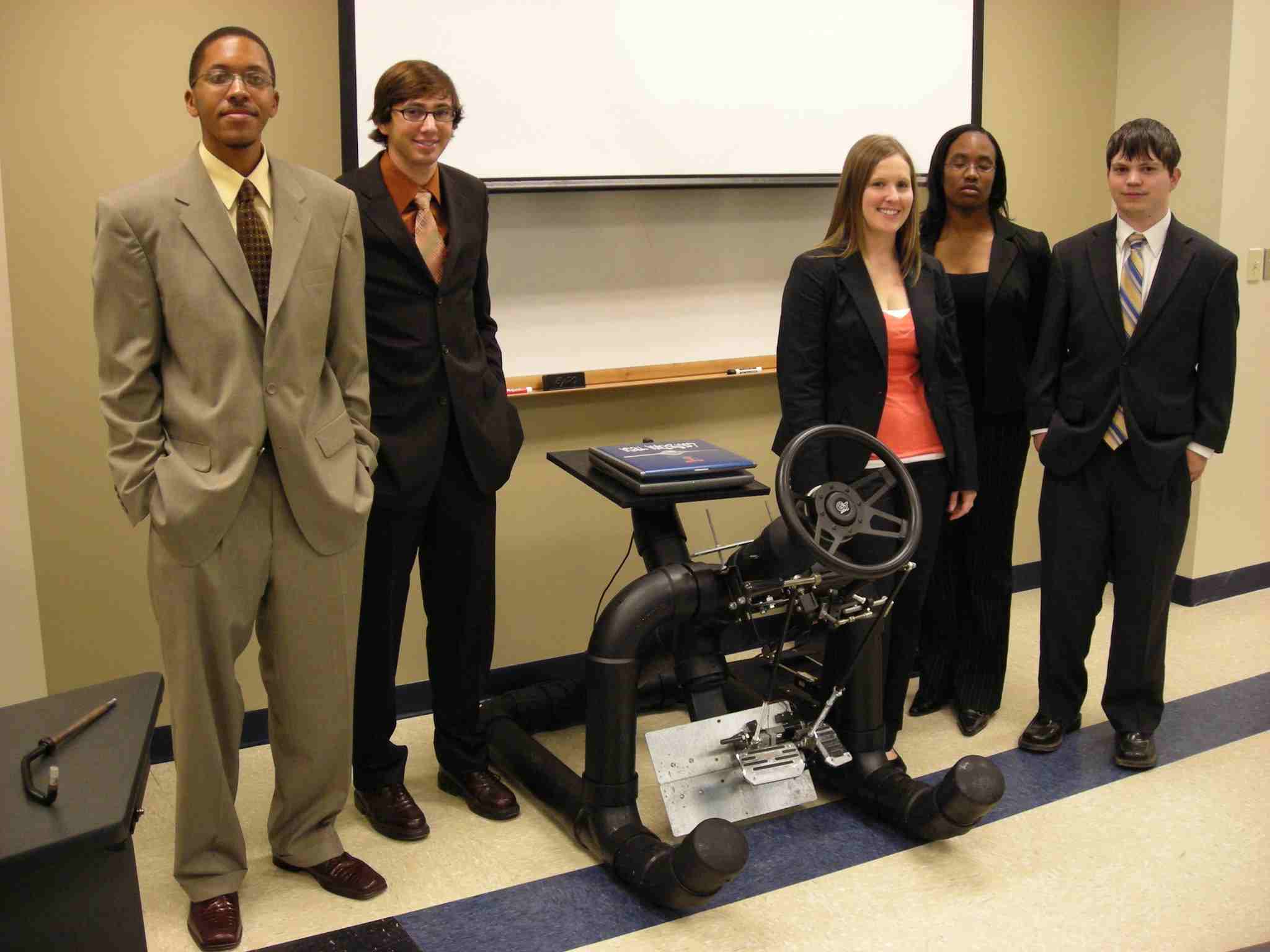
Driving Assessment Device. Jace Benoit, Amy Clemons, Drew Ford, Travis King, Rosalyn Pillow. (Sponsor: CREST)
Summary: The Driving Assessment Device (DAD) is a portable device designed to assess a patient’s ability to operate a vehicle with adaptive hand controls. Currently, two devices are in use but are not very portable, only incorporate one hand control each, and use an outdated reaction timer. This year’s device aims to improve these aspects by maintaining the portability, incorporating three, interchangeable hand controls, and developing a computer interface to measure reaction time. The computer interface simulates traffic lights with red and green stimuli. The user reacts to those lights by either depressing the brake or accelerator using one of the three, interchangeable hand control types: push-rock, push-right angle, or push-twist. The reaction time between the red light stimulus and the depression of the brake is recorded, and 20 trials are taken for each patient. The reaction times are then compared to national standards of reaction time percentiles to determine whether the patient falls within the appropriate percentiles. The percentile ranking that the patient achieves based on age will help the staff at CyBERS determine if patient is capable of driving a vehicle with an adapted hand control; if the patient’s reaction time meets national standards, the patient is more likely to be approved to drive with an adapted hand control.
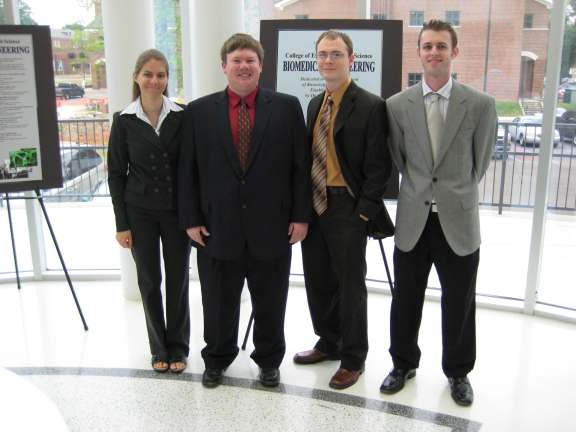
Analog Circuit Replacing Damaged Neurons: The NAC Rebecca Currier, John Grady, Philip Quinn, Patrick Thomas. (Sponsor: Chiu / Biomedical Engineering)
Summary: This project aims at modeling a system of two bidirectionally coupled hippocampal neurons in real time. Preferential damage to the hippocampus could be partially or fully restored with a real time, analog model of a neuronal system. The proposed device will consist of two oscillatory devices that range in frequency from 0.1 Hz to 100 Hz, achieve an action potential of +20mV (-70mV when inactive) and have an average refractory period of 5ms. The two said oscillatory devices will affect each other’s output frequency dynamically in real time, and will be able to interface and manipulate a living hippocampal slice’s output. The immediate result of this research project will be the ability to quickly and comprehensively extract data to better understand neurological function. The long term motivation of this project is to develop a more complex, effective device that will fully or partially repair preferentially damaged nerve function by bridging damage sections of the hippocampus together.
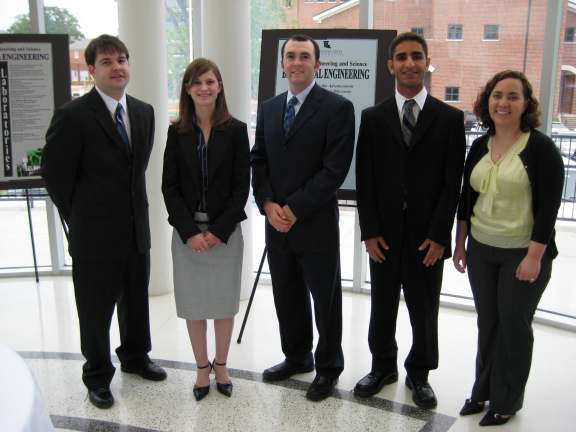
Modified-liposome encapsulated viral particles for enhanced drug delivery: Team Delivacure Sarah Jeffords, Scott Laura, Nicole Hataway, Eric Post, Saleh Ramezani. (Sponsor: Jill Williams / Biochemistry & Urology @ LSU-HSC / O'Neal)
Summary: This project aims to address the clinical necessity for a more efficacious cancer treatment to fight the second leading cause of death in America. The current techniques of surgery, chemotherapy, and radiotherapy are inadequate as a result of harmful side effects and the lack of specificity, and a novel technique is essential. A viable alternative is viral therapy, which targets specific tumor cells. The goal of this project is to deliver an increased number of viral particles to a specific tumor while evading the reticuloendothelial system. In addition, the particles will be fluorescently traceable in vivo and have a half-life greater than one hour. The target particle size is between 100-200 nm for optimal tumor uptake and the capacity to encapsulate 20 nm particles. The design prototype consists of viral particles encapsulated in a liposome. Following encapsulation, the liposomes are coated with a polyelectrolyte-dye solution (PAH/NIR-664) for fluorescent traceability, and coated with PEG to increase the particle circulation time. The liposomes are tailored to the desired size using a sonication technique. Preliminary studies have shown with 95% confidence that the liposomes can be manufactured to be 124.6 ± 4.11 nm, and the liposomes have been shown to be stable for at least 4 days. DLS, UV-Vis spectra, and FE-SEM analysis suggest proof of concept that nanoparticles can be encapsulated in the liposomes. Layer-by-layer assembly with PAH/NIR-664 and PEG were shown to be successful by gradually increasing the size of the particles with each layer, inverting the liposome charge with the dye solution, and masking the charge with PEG. The in vivo studies demonstrated dye clearance with a half-life of approximately 2 minutes, and suggested that the liposomes were accumulating in the lungs from which they are gradually released over time with a half-life much greater than 1 hour.
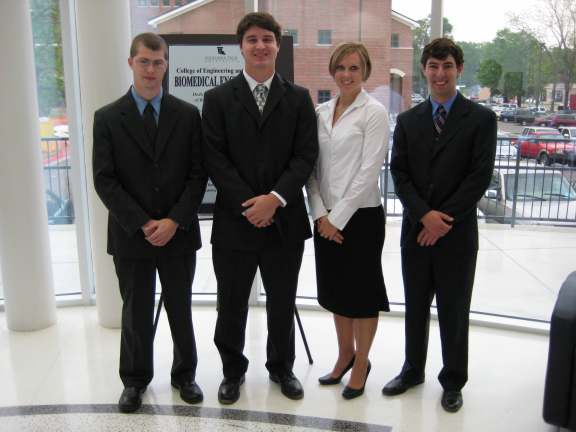
TitaniaCell: Jeffery Fontenot, Stephen McMullan, Austin Thompson, Jillann Walker. (Sponsor: Gold / Chemical Engineering)
Summary: This project aims to address the clinical need for modified titanium to be used on surgical implants, specifically titanium hip implants. Hip replacement surgery has become a common procedure for patients with major hip problems. Over 300,000 operations are performed each year and in 20% of these cases, aseptic loosening occurs as a result of osteolysis, or bone cell death. Current hip replacement products utilize a rough surface philosophy to improve the interaction between the hip implant and the inner surface of the proximal femur. We will utilize the anodization procedure on titanium to produce a uniform surface of nano-pores. Then a novel template wetting process deposits a polymer, polyvinylidene fluoride, onto the surface of the anodized titanium and into the pores, then an etching process removes the surface layer of TiO2 and leaves polymer nanotubes on the surface. The polymer nanotubes mimic the natural internal structures of the femur. This design utilizes the rough surface that currently works and adds the ability to deposit a polymer that will improve the viability of osteoblast cells and prevent the long-term defect of aseptic loosening due to osteolysis.

An optics based approach to measuring cell metabolism: Team Fibercell Pamela Christian, Scott Jewett, Lauren Reese, Sami Shalhoub. (Sponsor: Eklund / Chemistry)
Summary: Cell metabolism rate changes have been used for many years to determine cellular characteristics. Two important aspects of cell metabolism are pH changes and oxygen consumption rates. By quantitatively measuring cellular changes in pH and oxygen consumption rates, one can determine aspects such as cell health, cell growth, and presence and/or concentration of a drug. An optics-based fluorescent approach will be used in measuring oxygen consumption and pH changes of the cells. This approach will allow for the real-time and continuous monitoring. The optics system will be capable of measuring changes in light intensity due to oxygen and pH sensitive fluorophores, which will correspond to quantitative oxygen consumption rates and pH levels. Many current approaches to measuring pH and oxygen consumption rates, such as electrochemical methods, only take static measurements; however, our design will take real time measurements of both oxygen consumption rates and pH of cell cultures. An existing prototype developed by a senior design group will be used as a model for this project.